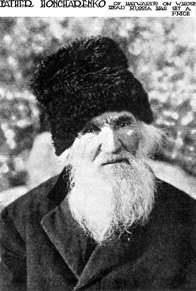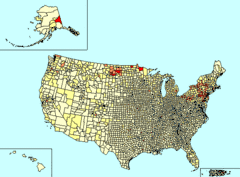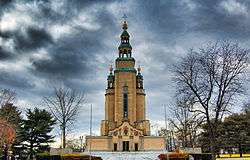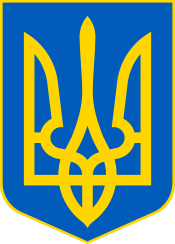Ukrainian Americans
Ukrainian Americans (Ukrainian: Українські американці, romanized: Ukrayins'ki amerykantsi) are Americans who are of Ukrainian ancestry. According to U.S. census estimates, in 2006 there were 961,113 Americans of Ukrainian descent representing 0.33% of the American population.[1] The Ukrainian population of the United States is thus the second largest outside the former Eastern Bloc; only Canada has a larger Ukrainian community under this definition. According to the 2000 U.S. census, the metropolitan areas with the largest numbers of Ukrainian Americans are: New York City with 160,000; Philadelphia with 60,000; Chicago with 46,000; Los Angeles with 34,000; Detroit with 33,000; Cleveland with 26,000; and Indianapolis with 19,000.[3][4] In 2018, the number of Ukrainian Americans surpassed 1 million.[5]
 | |
| Total population | |
|---|---|
| 976,314[1] 0.35% of US population (2009) | |
| Regions with significant populations | |
| New York City Metropolitan Area,[2] Rust Belt (Pennsylvania, Ohio, Michigan, Illinois), Midwest (Minnesota, North Dakota), Greater Los Angeles Area, Alaska, Washington state | |
| Languages | |
| American English, Ukrainian, Russian | |
| Religion | |
| Predominantly Ukrainian Orthodox and Ukrainian Greek Catholic, with Protestant and Jewish minorities | |
| Related ethnic groups | |
| Ukrainians, Ukrainian Canadians, Ukrainian Australians, British Ukrainians, Rusyn Americans, Belarusian Americans, Russian Americans, other Slavic peoples especially East Slavs |
History


The first Ukrainian immigrant to America, Ivan Bohdan, sailed with John Smith to the Jamestown colony in 1607. Bohdan met Captain Smith during the Long Turkish War of 1593–1606 when the latter had fought the Turks, was captured, and escaped captivity by fleeing through Ukraine, Romania, Hungary, and other countries.[7] Large-scale Ukrainian immigration to America did not begin, however, until the 1880s.[8]
From 1955 to 1965, St. Andrew Memorial Church in South Bound Brook, New Jersey was constructed as a memorial honoring victims of the Holodomor of 1932–1933.
The largest wave of Ukrainians came in the early 1990s, after the 1991 fall of the Soviet Union. A large number of those emigrating from Ukraine after the fall of the Soviet Union were Jewish or Protestant. Many Ukrainians of the newest immigration wave settled in large cities and regional centers, forming ethnic enclaves. In addition, many Ukrainian Americans arrived by way of Canada, which has a larger Ukrainian presence.
Ukrainian Americans living in Northern New Jersey and the remainder of the Northeastern United States have long been politically vocal about Ukrainian affairs, often traveling to Washington, D.C. to express their concerns.[9][10]
On September 21, 2015, in Bloomingdale (near Chicago), Filaret, Patriarch of Kyiv and All Rus'-Ukraine, consecrated the first North American monument to the Euromaidan "Heavenly Hundred".[11]
Demographics

As of the 2000 U.S. Census, there were 892,922 Americans of full or partial Ukrainian descent. The New York City Metropolitan Area contains by far the largest Ukrainian community in the United States, due to historically receiving the highest number of Ukrainian immigrants.[2]
The American states with the largest Ukrainian populations are as follows:
| New York | 148,700 |
| Pennsylvania | 122,291 |
| California | 83,125 |
| New Jersey | 73,809 |
| Ohio | 48,908[12] |
| Illinois | 47,623 |
The total number of people born in Ukraine is more than 275,155 residents.[13]
Ukrainian-born population
Ukrainian-born population in the US since 2010:[14]
| Year | Number |
|---|---|
| 2010 | 326,493 |
| 2011 | |
| 2012 | |
| 2013 | |
| 2014 | |
| 2015 | |
| 2016 | |
U.S. communities with high percentages of people of Ukrainian ancestry
The top 20 U.S. communities with the highest percentage of people claiming Ukrainian ancestry are:[15]
- Cass Township, Pennsylvania (Schuylkill County, Pennsylvania) 14.30%
- Belfield, North Dakota 13.60%
- Gulich Township, Pennsylvania 12.70%
- Gilberton, Pennsylvania 12.40%
- Wilton, North Dakota 10.30%
- Lumberland, New York 9.90%
- Saint Clair, Pennsylvania 8.80%
- Soap Lake, Washington 8.10%
- Frackville, Pennsylvania 7.60%
- Olyphant, Pennsylvania and Norwegian Township, Pennsylvania 7.00%
- Houtzdale, Pennsylvania 6.90%
- Harmony Township, Pennsylvania (Beaver County, Pennsylvania) and Kerhonkson, New York 6.70%
- Baden, Pennsylvania and McAdoo, Pennsylvania 5.90%
- Branch Township, Pennsylvania and Postville, Iowa 5.70%
- Woodward Township, Pennsylvania (Clearfield County, Pennsylvania) and Northampton, Pennsylvania 5.60%
- Warren, New York and Independence, Ohio 5.50%
- West Leechburg, Pennsylvania 5.40%
- Ambridge, Pennsylvania, Mount Carmel Township, Pennsylvania, and Parma, Ohio 5.30%
- Ford City, Pennsylvania 5.20%
- Bigler Township, Pennsylvania and Kline Township, Pennsylvania 5.10%
- Mayfield Heights, Ohio 3.4%
U.S. communities with the highest percentage of residents born in Ukraine
Top 20 U.S. communities with the highest percentage of residents born in Ukraine are:[16]
- Delta Junction, AK 16.4%
- Deltana, AK 8.4%
- West Hollywood, CA 7.8%
- Lumberland, NY 6.3%
- Moses Lake North, WA 6.0%
- Soap Lake, WA 6.0%
- Postville, IA 5.9%
- Webster, NY 4.8%
- Peaceful Valley, WA 4.8%
- Pikesville, MD 4.5%
- Kerhonkson, NY 3.9%
- North Highlands, CA 3.6%
- Rancho Cordova, CA 3.3%
- Flying Hills, PA 3.2%
- Waverly, NE 3.2%
- Fair Lawn, NJ 3.1%
- Buffalo Grove, IL 2.8%
- Feasterville-Trevose, PA 2.6%
- Smallwood, NY 2.5%
- Solvay, NY 2.5%
- North Port, FL 2.4%
Notable people
See also
- European Americans
- Hyphenated American
- The Ukrainian Museum (New York City)
- Ukrainian American Veterans
- Ukrainian Americans in New York City
- Ukrainian Americans in Los Angeles
- Ukrainian Australians
- Ukrainian Canadians
- Ukrainian Catholic Archeparchy of Philadelphia
- Ukrainian Congress Committee of America
- Ukrainian Orthodox Church of the USA
References
- "Census 2006 ACS Ancestry estimates". Factfinder.census.gov. Archived from the original on 2009-03-07. Retrieved 2012-04-01.
- "Yearbook of Immigration Statistics: 2010 Supplemental Table 2". U.S. Department of Homeland Security. Retrieved 2011-09-05.
- "Selected social characteristics in the United States: 2010 American Community Survey 1-Year Estimates". U.S. State Census Bureau. 2010. Archived from the original on February 12, 2020. Retrieved January 17, 2016.
- "Persons of Ukrainian Ancestry: States ordered by total number of Ukrainians". Informed Decisions, Inc. 2001. Archived from the original (XLS) on February 28, 2009.
- http://www.ukrweekly.com/uwwp/ukrainians-in-the-united-states-have-reached-1-million/
- "Yearbook of Immigration Statistics: 2011 Supplemental Table 2". U.S. Department of Homeland Security. Retrieved 2012-11-02.
- The Ukrainians in America: 1608-1975. (1976). Compiled and Edited by Vladimir Wertsman. New York: Oceana Publications.
- Paul Robert Magocsi. (1996). A History of Ukraine. Toronto: University of Toronto Press.
- Minjae Park (2014-09-18). "Ukrainian president greets North Jersey residents at D.C. rally". North Jersey Media Group. Retrieved 2014-09-18.
- Mary Diduch (August 24, 2015). "North Jersey Ukrainians pitch in for wounded countrymen". North Jersey Media Group. Retrieved August 31, 2015.
- "Monument to Heavenly Hundred unveiled in Chicago". UAWire.org. September 21, 2015. Retrieved February 21, 2020.
- "Total ancestry categories tallied for people with one or more ancestry categories reported: 2009 American Community Survey 1-Year Estimates". U.S. State Census Bureau. 2009. Archived from the original on February 15, 2015. Retrieved January 17, 2016.
- "Table FBP-1. Profile of Selected Demographic and Social Characteristics: 2000" (PDF). U.S. Census Bureau. 2000. Retrieved 2007-08-15.
- Bureau, U.S. Census. "American FactFinder - Results". factfinder.census.gov. Archived from the original on 2020-02-14. Retrieved 2018-04-23.
- "Ancestry Map of Ukrainian Communities". Epodunk.com. Archived from the original on 2013-05-23. Retrieved 2008-08-12.
- "Top 101 cities with the most residents born in Ukraine (population 500+)". city-data.com. Retrieved 2008-08-12.
Sources
- Kuropas, Myron B.; Shust, Maria; Pevna, Chrystyna (1984). To Preserve A Heritage: The Story of the Ukrainian Immigration in the United States. New York: The Ukrainian Museum. 84-050811.
- Magocsi, Paul R., ed. (1979), The Ukrainian Experience in the United States: A Symposium, Sources and Documents, Cambridge, Massachusetts: Harvard Ukrainian Research Institute, ISBN 0-916458-04-0
Further reading
- Fedunkiw, Marianne P. "Ukrainian Americans." in Gale Encyclopedia of Multicultural America, edited by Thomas Riggs, (3rd ed., vol. 4, Gale, 2014), pp. 459-474. online
- Lushnycky, Alex. Ukrainians of Greater Philadelphia (2007), ISBN 978-0-7385-5040-4
- Kuropas, Myron B.Ukrainians of Chicagoland (2006), ISBN 0-7385-4099-4
- Wichar, Nancy Karen. Ukrainians of Metropolitan Detroit (2010), ISBN 978-0-7385-7716-6

